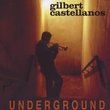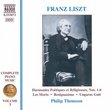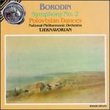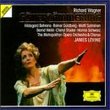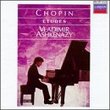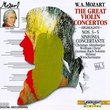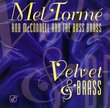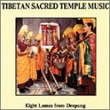| All Artists: Edvard Grieg, David Monrad Johansen, Oslo String Quartet Title: Grieg: String Quartet in G minor, Op. 27; String Quartet in F major; Johansen: String Quartet, Op. 35 Members Wishing: 0 Total Copies: 0 Label: Naxos Original Release Date: 1/1/1994 Re-Release Date: 6/28/1994 Genre: Classical Style: Chamber Music Number of Discs: 1 SwapaCD Credits: 1 UPC: 730099587921 |
Search - Edvard Grieg, David Monrad Johansen, Oslo String Quartet :: Grieg: String Quartet in G minor, Op. 27; String Quartet in F major; Johansen: String Quartet, Op. 35
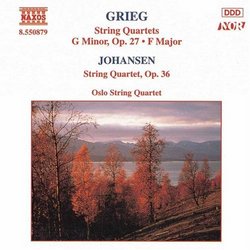 | Edvard Grieg, David Monrad Johansen, Oslo String Quartet Grieg: String Quartet in G minor, Op. 27; String Quartet in F major; Johansen: String Quartet, Op. 35 Genre: Classical
Grieg's only completed string quartet, Op. 27, usually sounds more like a reduction of an orchestral score than a work of chamber music. It's an attractive enough piece, but don't expect the kind of instrumental interplay ... more » |
Larger Image |
CD DetailsSynopsis
Amazon.com Grieg's only completed string quartet, Op. 27, usually sounds more like a reduction of an orchestral score than a work of chamber music. It's an attractive enough piece, but don't expect the kind of instrumental interplay you hear in the most famous quartets from Haydn to Shostakovich. The Oslo Quartet's strongly played interpretation makes a good case for it. Grieg's other half-quartet, in F, was a later piece that he never completed, and you can understand why when you hear it; it's neither prime Grieg nor totally uninteresting. The quartet by Johansen (1888-1974) was composed in 1969 but doesn't sound any more "advanced" in style than Grieg, so it makes a good coupling. --Leslie Gerber Similar CDs
Similarly Requested CDs
|
CD ReviewsDa non perdere Enrico | Padova, Italy | 05/11/2000 (5 out of 5 stars) "Un cd assolutamente delizioso. Il primo quartetto di Grieg è semplicemente sublime, tutto fuoco e ghiaccio, appassionato e placido, volubile eppure coerente. Il quartetto di Johansen è stato una piacevole scoperta. Il suono dell'Oslo String Quartet è fresco e pieno di vitalità, l'interpretazione fluida, precisa e senza fronzoli. Un cd davvero godibile, che consiglierei a tutti gli amanti della musica camera." A fine release G.D. | Norway | 05/25/2009 (4 out of 5 stars) "Edvard Grieg wrote his only completed string quartet in 1877-78, a work which is apparently partially autobiographical. The slow first movement introduction is based on an Ibsen-setting concerning a musician meditating on life and his beloved while walking along a stream on a summer evening (although I have to admit that I hear more of a stream on a summer evening than existential meditations on life and love). The theme is then transformed into a second theme in an allegro molto - familiar from the piano concerto and recurring throughout the work, laying the foundation for its cyclic structure; it interrupts the reflective second movement romanze and starts the intermezzo third movement as well as the last movement where it develops into a dance energetically moving towards an optimistic G major conclusion. The work as a whole is delightful, although not among Grieg's very best - more because the textures are somewhat opaque, revealing that Grieg cannot have been entirely comfortable with the idiom, than because of any shortcomings with respect to large-scale structures (which he is often, with some justification, accused of).
His next attempt, in F major from 1891, was aborted, but the two movements that exist are promising enough if not quite on the level of the g minor one. The first movement is full of interesting ideas but formally a little repetitive and unbalanced. The second scherzo movement is thoroughly enjoyable and inventive, however. David Monrad Johansen's (1888-1974) string quartet proves to be an effective coupling. It, too, is based on Norwegian folk music, but is far more modern-sounding and mildly dissonant, and benefits much from effective use of counterpoint. The first movement is based on a rather dissonant opening motif which gives way to a heavily contrapuntal gentler passage. The second movement is a harmonically less adventuresome scherzo while the third movement Largo is again more acerbic and based on folk music scales and traditional polyphony. The final movement is an energetic dance interrupted by a more tranquil contrapuntal passage - these two elements alternate, and the movement ends in an agitato transformation of the opening motto from the first movement. It is overall a very interesting and resourceful work that certainly deserves a listen. The performances by the Oslo String Quartet are generally impressive (if not quite on the level of their later performances of the Nielsen quartets), intimately expressive and able to bring out the subtle colorations and shades in all three works, lively and sprightly if slightly rough at the edges at times. I have to say that the dynamic range sounds somewhat limited as well, and one can imagine somewhat bigger gestures and bolder strokes in the music-making (I have to admit that my experience with alternative performances is limited, though), although I don't on the whole think anyone will go seriously amiss with these versions. Sound quality is more than decent." |

 Track Listings (10) - Disc #1
Track Listings (10) - Disc #1